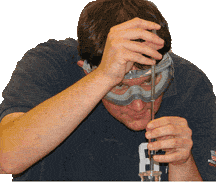Overall dilution
What if you do dilute and then dilute again? For example, in our cold press example, the original dilution factor was 1/5, and the second dilution factor was 1/10. So,
strong coffee had 1/5th of the caffeine in the brew, and
wimpy coffee had 1/5th of 1/10th = 1/50th of the caffeine in the brew.
As you can see, it makes sense to multiply the dilution factors to find the overall dilution factor. This works regardless of how many dilutions you do.
overall dilution factor = dilution factor 1 * dilution factor 2 * dilution factor 3 * ...
 Over at Sunbucks, the manager would like to make a kids version of the drink that will only have 1/100th of the caffeine of the original brew. How can he do this?
Over at Sunbucks, the manager would like to make a kids version of the drink that will only have 1/100th of the caffeine of the original brew. How can he do this?
He could take the wimpy coffee (dilution factor 1/50) and apply a dilution of 1/2, since 1/50 * 1/2 = 1/100.
And how can he achieve a dilution factor of 1/2?
He could transfer 1 cup of wimpy coffee and add 1 cup of water.
Or if he had a big group coming, he could transfer 6 cups of wimpy coffee and add 6 cups of water.
Or there are lots of other ways of making a 1/2 dilution.
Could he make the kids drink in some other way (not involving a 1/2 dilution)?
Sure, he could start with the strong coffee (1/5 dilution) and make a second dilution:
1/5 * 1/20 = 100. (One cup coffee plus 19 cups water)
Or he could do it in two extra steps:
1/5 * 1/5 * 1/4 = 1/100.
As you can see, there are lots of ways of getting to the same overall dilution.
Back to the lab: (PIC to illustrate)
We start with a concentrated stock of meningicocci virus and perform the following dilutions:
| Add 1 mLto 9 mL water | Dilution factor |
|---|---|
| then, add 1 mL to 99 mL water | Dilution factor |
| then, add 1 mL to 99 mL water | Dilution factor |
| What was the overall dilution factor? |
As a way to double-check, you can think the dilution process through logically. Often it helps to think through the whole process using some concrete number. For example, if you did two 1/100 dilutions, you could think about it like this: "I started with 300,000 cells in a mL, and put them into 99 mLs of saline, and took out a mL, so there must have been 3,000 cells in that mL. Then I put those 3,000 cells into 99 mLs of saline, and took out one mL again, so there must have been 30 cells in that mL. Overall my dilution must have been to 30 from 300,000, which is the same as to 1 from 10,000 (1:10,000)." Of course, the idea that you started with 300,000 cells is pure fiction, but it can help you make sure that you've done the dilutions correctly.
Copyright University of Maryland, 2007
You may link to this site for educational purposes.
Please do not copy without permission
requests/questions/feedback email: mathbench@umd.edu